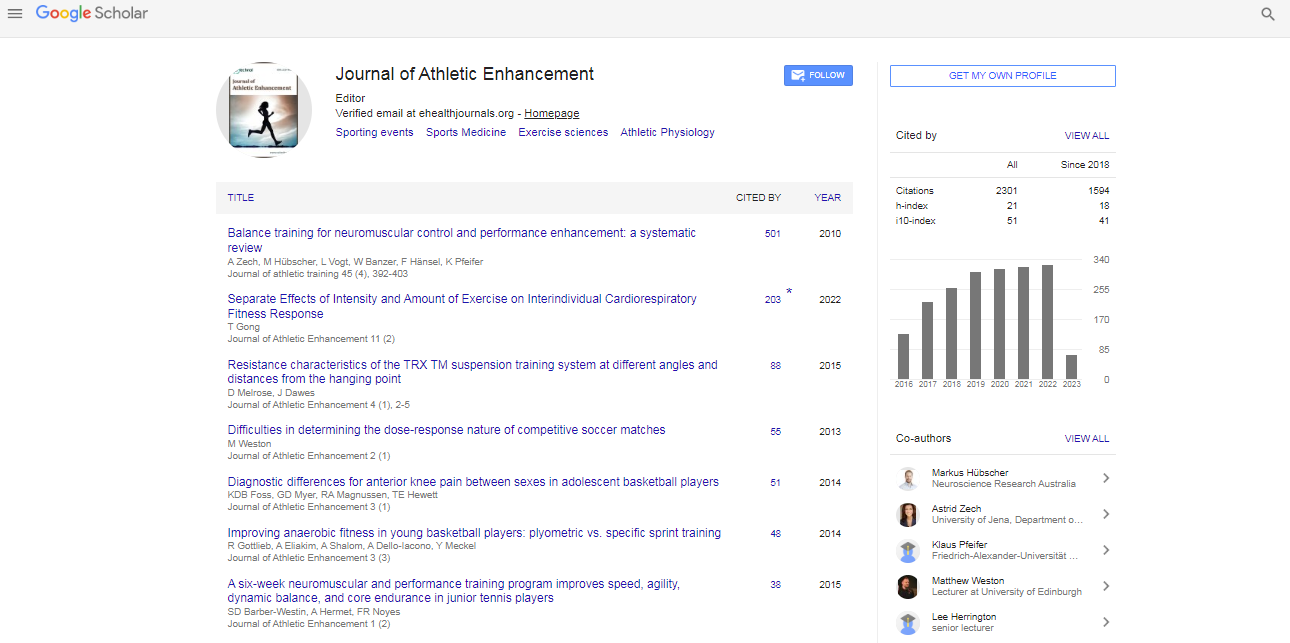Commentary, J Athl Enhanc Vol: 12 Issue: 6
An Overview on Physical Fitness: Its Challenges and Solutions
Gardner Farag*
1Department of Sport Nutrition, University of Sydney, Sydney, Australia
*Corresponding Author: Gardner Farag,
Department of Sport Nutrition, University
of Sydney, Sydney, Australia
E-mail: mantonikolaidi@gmail.com
Received date: 30 October, 2023, Manuscript No. JAE-24-124073;
Editor assigned date: 02 November, 2023, PreQC No. JAE-24-124073 (PQ);
Reviewed date: 16 November, 2023, QC No. JAE-24-124073;
Revised date: 23 November, 2023, Manuscript No. JAE-24-124073 (R);
Published date: 30 November, 2023 DOI: 10.4172/2324-9080.100087
Citation: Farag G (2023) An Overview on Physical Fitness: Its Challenges and Solutions. J Athl Enhanc 12:6.
Description
Physical fitness is an essential component of overall health and well-being, encompassing various aspects of the body's ability to function efficiently. It involves a combination of factors that contribute to optimal bodily function, including cardiovascular endurance, muscular strength, flexibility, and body composition. Achieving and maintaining physical fitness not only enhances physical health but also positively impacts mental and emotional well-being.
Importance of physical fitness
Health benefits: Regular physical activity and fitness contribute significantly to reducing the risk of chronic diseases like heart disease, diabetes, obesity, and certain cancers. It improves cardiovascular health, strengthens the immune system, and enhances overall vitality..
Mental well-being: Engaging in physical fitness activities releases endorphins, neurotransmitters that promote feelings of happiness and reduce stress. It aids in combating anxiety, depression, and other mental health conditions by promoting better sleep and boosting selfesteem.
Enhanced performance: Being physically fit improves performance in daily tasks, work-related activities, and sports. It enhances agility, coordination, and stamina, making routine activities more manageable and enjoyable.
Longevity: Studies consistently show that individuals who maintain a higher level of physical fitness tend to live longer and have a better quality of life as they age.
Components of physical fitness
Cardiovascular endurance: This refers to the ability of the heart, lungs, and circulatory system to deliver oxygen and nutrients to the body's tissues during sustained physical activity. Activities like running, swimming, cycling, and dancing improve cardiovascular endurance.
Muscular strength and endurance: Building muscular strength involves resistance training or weightlifting exercises that increase the force muscles can exert. Muscular endurance refers to the ability of muscles to perform repetitive movements over an extended period. Both are crucial for overall fitness and functionality.
Flexibility: Flexibility exercises such as stretching or yoga help maintain and improve the range of motion in joints, preventing injuries and improving posture.
Body composition: This refers to the proportion of fat, muscle, bone, and other tissues in the body. Achieving a healthy body composition involves managing body fat percentage through a balanced diet and regular exercise.
Ways to achieve physical fitness
Regular exercise: Engaging in a variety of physical activities, including aerobic exercises, strength training, flexibility exercises, and balance training, is crucial for overall fitness. Aim for at least 150 minutes of moderate-intensity aerobic activity or 75 minutes of vigorous-intensity aerobic activity per week, along with musclestrengthening activities on two or more days a week.
Balanced diet: A well-balanced diet that includes a variety of nutrients is essential for supporting physical fitness. This includes a combination of carbohydrates, proteins, healthy fats, vitamins, and minerals to fuel the body for exercise and recovery.
Adequate rest and recovery: Giving the body enough time to rest and recover is as crucial as exercise. Proper sleep, hydration, and allowing muscles to recover between workouts are vital for overall fitness and performance.
Consistency: Consistency is key to achieving and maintaining physical fitness. Setting realistic goals and establishing a regular exercise routine can help in staying motivated and seeing progress over time.
Challenges and solutions
Lack of time: In today's busy world, finding time for exercise can be challenging. Solution: Incorporate physical activity into daily routines, such as taking the stairs, walking during breaks, or scheduling workouts as non-negotiable appointments.
Lack of motivation: Staying motivated to exercise regularly can be difficult. Solution: Find activities that are enjoyable, set achievable goals, vary workouts to avoid monotony, and consider exercising with a friend or hiring a personal trainer for accountability.
Injuries: Overexertion or improper form during exercise can lead to injuries. Solution: Start slowly, warm up before workouts, use proper techniques, and listen to the body's signals to avoid overtraining.
Physical fitness is a cornerstone of a healthy lifestyle. By incorporating regular exercise, maintaining a balanced diet, and prioritizing rest and recovery, individuals can achieve and sustain optimal physical fitness, leading to improved health and well-being across various aspects of life.
 Spanish
Spanish  Chinese
Chinese  Russian
Russian  German
German  French
French  Japanese
Japanese  Portuguese
Portuguese  Hindi
Hindi 
